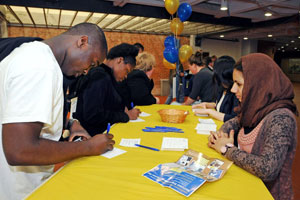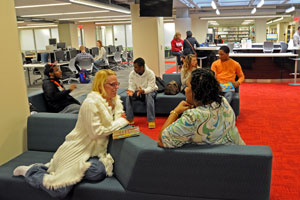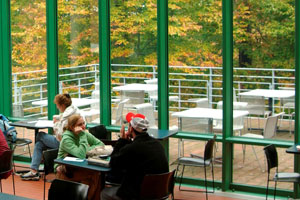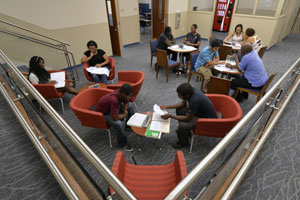2017 Juror: Odili Donald Odita

Odili Donald Odita is an abstract painter whose work explores color both in the figurative historical context and in the sociopolitical sense. Odita has said, “Color in itself has the possibility of mirroring the complexity of the world as much as it has the potential for being distinct. The organization and patterning in the paintings are of my own design. I continue to explore in the paintings a metaphoric ability to address the human condition through pattern, structure and design, as well as for its possibility to trigger memory. The colors I use are personal: they reflect the collection of visions from my travels locally and globally. This is also one of the hardest aspects of my work as I try to derive the colors intuitively, hand-mixing and coordinating them along the way. In my process, I cannot make a color twice – it can only appear to be the same. This aspect is important to me as it highlights the specificity of differences that exist in the world of people and things.” Odita goes on to express his desire to speak positively about Africa and its rich culture through his work.
In recent years, Odita has been commissioned to paint several large-scale wall installations including The United States Mission to the United Nations in New York (2011), the Savannah College of Art and Design (2012), New York Presbyterian Hospital (2012), New Orleans Museum of Art (2011), Kiasma, Helsinki (2011) and the George C. Young Federal Building and Courthouse in Orlando, Florida (2013).
Odita has had several solo exhibitions in museums and institutions across the globe including Savannah College of Art and Design; Yerba Buena Center for the Arts, San Francisco; Contemporary Arts Museum, Houston; Studio Museum in Harlem; Institute of Contemporary Art, Philadelphia; Ulrich Museum of Art, Wichita; and Princeton University.
Odita was born in 1966 in Enugu, Nigeria and lives and works in Philadelphia. He has been the recipient of a Penny McCall Foundation Grant in 1994, a Joan Mitchell Foundation grant in 2001, and a Louis Comfort Tiffany Grant in 2007. Also in 2007, his large installation Give Me Shelterwas featured prominently in the 52nd Venice Biennale exhibition Think With The Senses, Feel With the Mind, curated by Robert Storr.
He has been represented at The Jack Shainman Gallery since 2006. Solo exhibitions at the gallery include Velocity of Change (2016), Body & Space (2010), Fusion (2006). He has curated an exhibition at the gallery titled The Color Line (2007) and a solo exhibition, This, That and the Other (2013).
Photos
Accepted Artists
Shwarga Bhattacharjee
Claudia Bokulich
Lily Brown
Max Budnick
Nicholas Burns
Moira Connelly
Jennifer Davies
Rayna DeReus
Enrica Ferrero
Lauren Fueyo
Adrienne Hall
Morgan Hobbs
Yaochi Jin
Marisa Karis
Kelly Kuykendall
Brandon Leistman
Siyuan Liu
Timothy Magenta
James Maurelle
Andrew Negrey
Jermaine Ollivierre
Emma Oslé
Jiaqi Pan
Stephanie Price
Frankie Reyes
Kevin Rose
Jackie Rosenzweig
Calli Ryan
Carol Tashjian
Heryk Tomassini
Autumn Wallace
Dave Walsh
Han Wang
William Warden
Jon Weary
Kenneth Winterschladen
Rachel Zimmerman
Code Switch Manifesto
In linguistics, code-switching occurs when a speaker alternates between two or more languages, or language varieties, in the context of a single conversation. Code-switching is distinct from other language contact phenomena, such as borrowing, pidgins and creoles, loan translation (calques), and language transfer (language interference). Borrowing affects the lexicon, the words that make up a language, while code-switching takes place in individual utterances. Speakers form and establish a pidgin language when two or more speakers who do not speak a common language form an intermediate, third language. On the other hand, speakers practice code-switching when they are each fluent in both languages.
In the 1940s and the 1950s, many scholars considered code-switching to be a substandard use of language. Since the 1980s, however, most scholars have come to regard it as a normal, natural product of bilingual and multilingual language use. Code-switching relates to, and sometimes indexes social-group membership in bilingual and multilingual communities. Some sociolinguists describe the relationships between code-switching behaviors and class, ethnicity, and other social positions.
Some discourse analysts, including conversation analyst Peter Auer, suggest that code-switching does not simply reflect social situations, but that it is a means to create social situations.
Becoming human should not be taken for granted, Lear writes. It is something we accomplish, something we get the hang of, and like Kierkegaard and Plato, Lear claims that irony is one of the essential tools we use to do this. For Lear and the participants in his Socratic dialogue, irony is not about being cool and detached like a player in a Woody Allen film. That, as Johannes Climacus, one of Kierkegaard’s pseudonymous authors, puts it, “is something only assistant professors assume.” Instead, it is a renewed commitment to living seriously, to experiencing every disruption that shakes us out of our habitual ways of tuning out of life, with all its vicissitudes.
This exhibition is about irony. In a specific sense, it is about the utilization of the ironic to speak to a condition that has visibly permeated the air in the United States of America since the conclusion of the 2016 Presidential election. What I speak to is the disturbance of meaning and truth, and how we now engage these systems in an age of post-fact and fake news.
During the jury process, I was interested in how the works selected for this exhibition picture one thing, or a set of things in particular, yet address something else resoundingly different and extending far beyond what one might literally see in the work itself. Many questions came to mind. What are theses works doing and why? What are the various conditions in place that make these actions pertinent? And how are these artists aware of the linguistics they employ in their attempts to convey and communicate? These are some of the questions I want to bring to the table as one contemplates the works on view in this exhibition. I want to know how these works begin to address notions of what is real in truth and circumstance, within a present tense.
I am looking into the condition of the thinning membrane between pure aesthetics and the social, and investigating the actions taken by each of these artists to make this present in their work. I want to make evident in this exhibition that the skin between life and artifice can be non-existent. I hope to show that art can exist within life where one disappears into the other, and vice-versa.
We are living in a time of great stress, where trust in the other is at best, tenuous. Our neighbor, who once had our interest at heart, may now want us deported. And confidence is lacking in most things done today. We have lost our sense of a system that at one time kept truth intact and doubt at bay. Everyday is a retribution ritual reset for past deeds done wrong, and it’s to know that all of us will have our turn to be burned within the mob-run social hubs that link us all together.
Perspective is a vantage point that is always taken personally, and it has insidiously been this point that colonizes, in as much as it defines. We have never let go of the notion of ‘self’ when it comes to this point. This space is all encompassing, even when we have nothing, nor want anything to do with it.
We are unfortunately living in the age of instant gratification. This age is called the Internet. It has slowed our movement, our thinking, and our senses as it gives us all and everything we need; sex, medical help, life-tips, and ego-boost through the intense abuse of others, and all executed in the prophylactic of distance. With the click of a key we can satisfy our fix for shopping, along with all other curiosities we hold in the dark. And like the one-armed bandit of yesterday, the eternal return of chance is Buddha and body – it’s our one-way death-trip from corporeality toward the silence at the center of our mind.
We have lost our means of investigating things deeply. Speed is our currency. We need to be rocked and shocked, intensely, and at all times. Otherwise, we will experience boredom, and boredom needs to be avoided at all cost. Boredom means taking time to smell things like roses, and this can simply stink. Uncertainty without the calculated statistic is not the kind of chance we are willing to take. This is boring, and again, it stinks. We cannot risk the loss of time – electricity waits for no man/woman, nor droid. Everything is made for our entertainment, and entertainment is everything. We no longer have access to our senses to see anything in anyway. Things have to be spelled out, because we have lost our ability to read. It has to be obvious, and it has to be literal, otherwise we will have to engage the unknown challenges of emotional integrity, and that’s something better left for lost in the wild, wild, west.
I believe the artist participants in this exhibition see that the Internet surrounds us, and yet the smell of ‘faked news’, for example, has not made them dumb, nor blind. With these works, there is still hope in the air, even in the face of hopelessness that rules our borders daily. These select artists show their incredible skill, ingenuity and fortitude by navigating discursive channels of communication in order to reach through the uneasy truth of our social dissolution. The point is to see how these artists create new discourses, and a new language of hope that challenges the despair of deplorable, extremist visions wanting us to return to ways that are long dead. We have to learn to speak again, and celebrate the ways in which action can guide our variant, collective voices and vision onward and forward in time and space.
Odili Donald Odita
Philadelphia, December 2017













